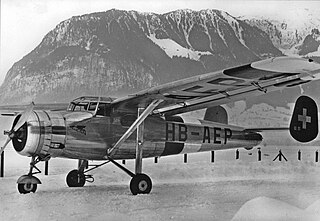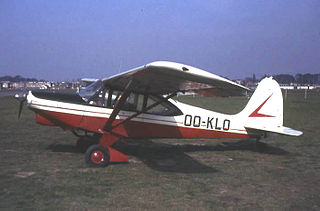
The Pilatus P-2 is a trainer aircraft designed by Swiss manufacturer Pilatus in 1942 and first flown on April 27, 1945. It was used by the Swiss Air Force from 1946 until 1981. The Pilatus P-2 emerged from an unbuilt project of the Pilatus P-1, which can be seen as a single-seat version of the P-2.

The Pilatus P-3 was a military training aircraft built by Pilatus Aircraft of Switzerland.

The Pilatus SB-2 Pelican was a civil utility aircraft developped by a purposely founded development bureau at the ETH Zurich on behalf of the Federal Air Authority. In November 1940 it was decided to go on with the project and build the aircraft, in February 1941 the Authority approved the development bureau to have it built at the newly formed Pilatus Aircraft company.

The Aubert PA-20 Cigale, PA-204 Cigale Major and PA-205 Super Cigale were a family of high-wing cabin monoplanes built in France in the years immediately before and immediately after World War II. The original Cigale was shown at the 1938 Paris Salon but its development was interrupted by the War. The Cigale was a high wing cantilever monoplane of conventional configuration with fixed, tailwheel undercarriage.

The Boisavia B.60 Mercurey was a series of four-seat light aircraft developed in France shortly after World War II.

The Fokker F.25 Promotor, first flown in 1946, was a single-engined, twin-boomed, four-seat passenger monoplane with a pusher engine mounted at the rear of a central nacelle. It was of wooden construction and has fitted with a retractable nosewheel undercarriage. One feature of the design was that instead of a 2 + 2 seating, the pilot sat in front to the left, and all three passengers were on a bench seat to the rear of him. Alternatively, when being used as an air ambulance aircraft, it could carry a patient on a stretcher, which was loaded through a hatch in the aircraft's nose. The F.25 was evocative of the pre-war G.I design.

The Call-Air Model A is an American two- to three-seat utility aircraft designed by the Call brothers and built by the Call Aircraft Company, later developed into a successful line of agricultural aircraft.

The Colonial Model C-1 Skimmer was an American small single-engined amphibian flying boat built by the Colonial Aircraft Corporation. It was the start of a line of very similar aircraft designed by David Thurston.

The CNNA HL-6 was a civil trainer aircraft developed in Brazil in 1943.

The Piaggio P.148 was a 1950s Italian two-seat primary or aerobatic training monoplane designed and built by Piaggio Aero.

The FMA 20 El Boyero ("Shepherd") was a light utility aircraft produced in Argentina in the 1940s. It was a conventional high-wing strut-braced monoplane with fixed tailskid undercarriage with seating for two side by side in an enclosed cabin.

The Malmö MFI-10 Vipan was a four-seat light utility monoplane designed and built in Sweden by Malmö Flygindustri. Only three aircraft were built and the type did not enter quantity production.

The Meyers MAC-125 is a light sport aircraft developed in the United States in 1947, produced in a small series as the MAC-145.

The Ambrosini Rondone is an Italian-designed two/three-seat light touring monoplane of the early 1950s.

The Baumann Brigadier was a prototype American light transport aircraft of the late 1940s. It was a twin-engined monoplane, which, unusually, was of pusher configuration. Only two were built, plans for production never coming to fruition.

The I.S.T. XL-14 Maya was a single-engine, light experimental aircraft designed and built in the Philippines in the early 1950s to investigate the use of indigenous materials in aircraft construction. Its construction uses a type of woven bamboo.

The I.S.T. XL-15 Tagak was a single-engine, twin-boom, high-wing monoplane designed after the I.S.T. XL-14 Maya and built in the Philippines in the mid-1950s. The result of a collaboration between a Government research institute and the Philippine Air Force, it was designed as a utility, liaison or ambulance aircraft and as a test bed for the use of local materials in aviation.
The I.S.T. L-17 Masang was a two-seat, single engine, low wing monoplane aircraft designed and built in the Philippine Republic in the mid-1950s. It was intended for both touring and training.

The Aviamilano F.14 Nibbio is a four-seat, single engine cabin monoplane built in Italy in the late 1950s. Only ten production aircraft were completed.

The Kawasaki KAL-2 is a Japanese four/five seat, single engine aircraft, designed for both military and civil markets in the mid-1950s. Only two were completed.



















